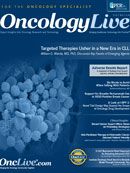Publication
Article
Oncology Live®
Yoga Lessens Fatigue and Inflammation in Breast Cancer Survivors
Author(s):
Breast cancer survivors who took two yoga classes a week for 3 months after treatment were less fatigued and demonstrated less systemic inflammation than their counterparts who did not take the classes
Breast cancer survivors who took two yoga classes a week for 3 months after treatment were less fatigued and demonstrated less systemic inflammation than their counterparts who did not take the classes, according to study results published recently in the Journal of Clinical Oncology. Kiecolt-Glaser et al, embarked on the study because cancer survivors are more likely than cancer-free individuals to be in poor health and are less likely to exercise, leaving them easily fatigued. Furthermore, inflammation is thought to contribute to declining physical function and activity, and physical activity is associated with lower inflammation rates.
“We hypothesized that yoga would decrease inflammation, depressive symptoms, and fatigue in contrast to those characteristics in the . . . control group,” the authors wrote.
The trial compared a hatha yoga regimen of two 90-minute sessions per week for 12 weeks against results in a cohort that was wait-listed for the exercise program. The study included 200 stage 0 to IIIA breast cancer survivors aged 27 to 76 years who had completed treatment within the past 3 years and at least 2 months prior to entering the trial.
Outcomes were measured using patient self-scores on the Multidimensional Fatigue Symptom Inventory-Short Form, the Medical Outcomes Study 36-item Short Form for vitality, and the Center for Epidemiological Studies-Depression scale.
Via blood tests, the study also measured patients for lipopolysaccharide-stimulated production of proinflammatory cytokines interleukin-6 (IL-6), tumor necrosis factor alpha (TNF-α), and interleukin-1ß (IL-1ß). The investigators found that mean fatigue was significantly lower in the yoga group at the 3-month mark (5.4 vs 12.4; P = .002). The average vitality score was also higher at 3 months (58.1 vs 51.6; P = .01). Depression scores were not significantly different between groups.
Also at 3 months, the yoga group had significantly reduced cytokine levels compared with the control group. The estimated geometric mean lipopolysaccharide-stimulated production of TNF-α was 13% lower in the yoga group (P = .027); production of IL-6 was 15% lower (P = .027); and production of IL-1β was 20% lower (P = .037). “If yoga dampens or limits fatigue and inflammation, then regular practice could have substantial health benefits,” the authors wrote.
Kiecolt-Glaser J, Bennett JM, Andridge R, et al. Yoga’s impact on inflammation, mood, and fatigue in breast cancer survivors: a randomized controlled trial [published online January 27, 2014]. J Clin Oncol.




























%20(2)%201-Recovered-Recovered-Recovered-Recovered-Recovered-Recovered-Recovered-Recovered-Recovered-Recovered-Recovered-Recovered-Recovered-Recovered-Recovered-Recovered-Recovered.jpg?fit=crop&auto=format)
%20(2)%201-Recovered-Recovered-Recovered-Recovered-Recovered-Recovered-Recovered-Recovered-Recovered-Recovered-Recovered-Recovered-Recovered-Recovered-Recovered-Recovered-Recovered.jpg?fit=crop&auto=format)
